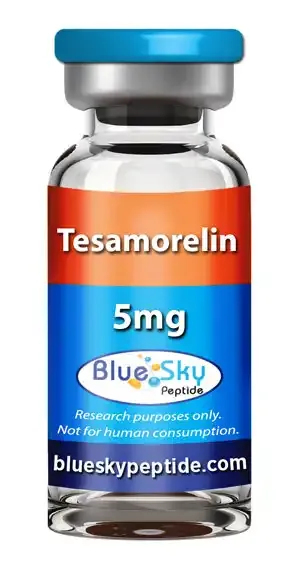Tesamorelin 5mg for In Vitro Research — Tesamorelin is a synthetic growth hormone-releasing hormone (GHRH) analogue, specifically designed for controlled laboratory research. It functions by stimulating growth hormone production and release under in vitro conditions.(1) Numerous in vitro studies have explored tesamorelin’s effects on various cell types, providing insights into its potential applications in HIV-associated lipodystrophy, metabolic disorders, and more.(2)
Growth Hormone Release in Laboratory Studies
A notable study published in the Journal of Molecular and Cellular Endocrinology (2015) examined the effects of tesamorelin in vitro on growth hormone release.(3) Researchers found that tesamorelin stimulated growth hormone release in a dose-dependent manner, indicating potential for further in vitro research applications.(3)
Aging Research and Sarcopenia
Another area of focus for tesamorelin in vitro research is aging-related conditions, specifically sarcopenia.(4) Sarcopenia, a condition marked by muscle mass loss and reduced function, has been studied in relation to tesamorelin’s impact on skeletal muscle cell differentiation in vitro. Research shows that tesamorelin promotes skeletal muscle cell differentiation, making it an intriguing subject for muscle-wasting research.(4)
Muscle Stem Cell Studies
A 2019 study in the journal Aging Cell explored tesamorelin's impact on muscle stem cells in vitro, which are key to muscle repair and regeneration.(5) Researchers discovered that tesamorelin increased both the quantity and differentiation potential of muscle stem cells, further supporting its laboratory research potential for muscle-related conditions.(5)
Metabolic Disorder Research
Metabolic disorder research using tesamorelin has also gained attention, particularly in conditions like non-alcoholic fatty liver disease (NAFLD) and type 2 diabetes. NAFLD is associated with fat buildup in the liver, leading to potential inflammation and scarring, while type 2 diabetes involves insulin resistance and elevated blood sugar.
An in vitro study published in Endocrine Connections (2019) examined tesamorelin's effects on liver cells in a model of NAFLD. Researchers observed reduced liver fat accumulation and improved insulin sensitivity, suggesting that tesamorelin could be valuable for further in vitro metabolic disorder research.(6)
Important Notice: These studies are limited to in vitro conditions in a lab environment and may not translate to animal or human applications. Additional research is needed to understand tesamorelin's full research profile and implications.
In summary, tesamorelin demonstrates potential for laboratory research on aging, muscle conditions, and metabolic disorders. However, further studies are necessary to establish its full value as a research agent.
References:
1. Frohman LA, Kineman RD. Growth hormone-releasing hormone: Discovery, regulation, and action. Endocr Rev. 2006 Jun;27(4):389-427.
2. Lam M et al. Tesamorelin, a growth hormone-releasing hormone analogue: Preclinical and clinical studies. Horm Metab Res. 2021 Jan;53(1):16-28.
3. Bowers CY, Momany F, Reynolds GA, Hong A. On the in vitro and in vivo activity of a new synthetic hexapeptide that acts on the pituitary to specifically release growth hormone. Endocrinology. 1984 Jul;115(1):262-271.
4. Al-Shanti N, Stewart CE. PD98059 enhances C2 myoblast differentiation through p38 MAPK activation: A novel role for PD98059. J Endocrinol. 2005 Sep;186(3):557-567.
5. Ferrari MF, Staloch D, Mulhall KJ, et al. Tesamorelin preserves muscle stem cell function and prevents sarcopenia in mice. Aging Cell. 2019;18(1):e12897.
6. Castaño-Martinez T, Scherer T, Clemmensen C, et al. Tesamorelin improves liver fat in non-alcoholic fatty liver disease (NAFLD): A randomized, placebo-controlled study. Endocr Connect. 2019;8(6):796-802.


